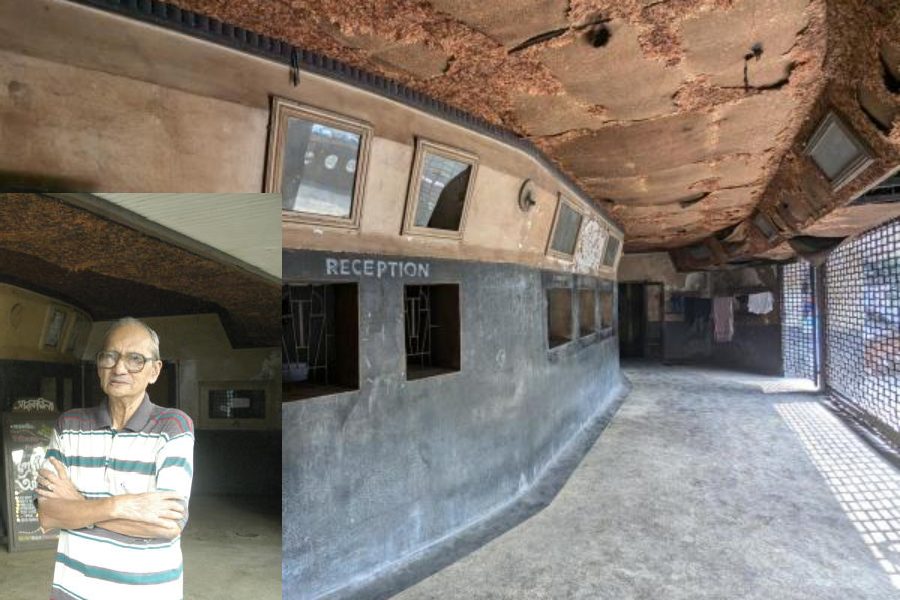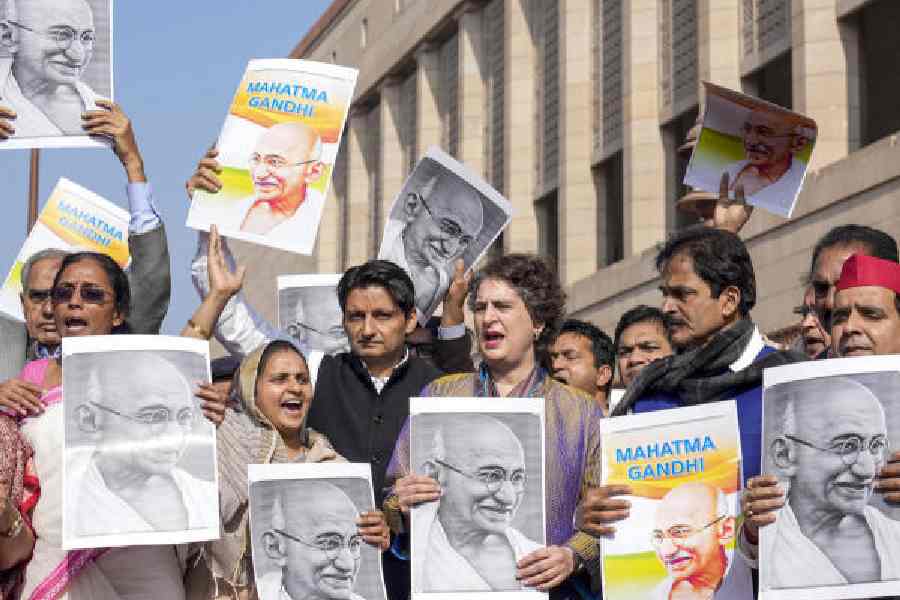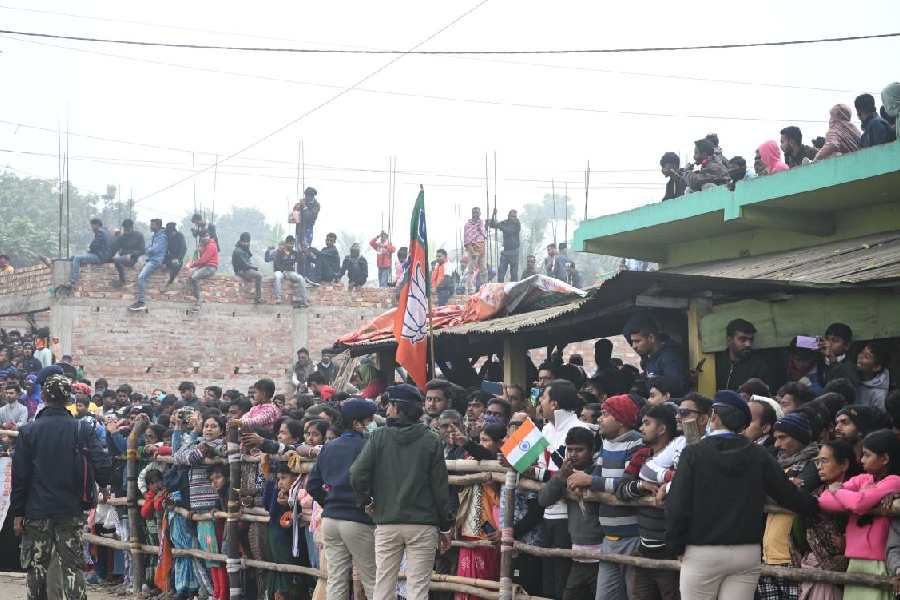There is a saying in Bengali that goes — pull the ear and the head will appear. A story about Amar Ghosh, who was actor, director, theatre-designer and also owner of Calcutta’s Circarena theatre, is incomplete without a brief history of Hatibagan. To work out which is the figurative head and which is the ear is not the lookout of this piece.
Hatibagan, the north Calcutta neighbourhood, takes its name most likely from the parked pachyderms of Siraj ud-Daulah. In the mid-18th century, this is where the Nawab of Bengal parked his war elephants before he launched an attack on the East India Company. Later, trader Mehtab Chand Mullick founded a market in the same area. Today, Hatibagan is known for its shops and famous for its community Durga Pujas.
Last October, one of the popular draws was the puja at Hatibagan’s Nabin Pally. Its theme was the lost theatrepara. The pandal was made of giant posters of blockbuster plays, models of auditoriums carved out of plywood and cutouts of legendary theatre artistes.
Amitava Ray, chief organiser of the Nabin Pally puja, says, “It was an opportunity to draw attention to a vibrant cultural hub that got wiped out around 2008.”
That Hatibagan used to be Calcutta’s theatre hub in the 20th century is indeed easy to forget. Heritage theatres seem to court fire here like no other place. In 1991, Star Theatre was gutted; in August 2001, Rangmahal and in October, Biswarupa. Bijon Theatre too is long gone.
Only two dilapidated theatres remained — Rangana and Circarena. Of the two, Rangana was taken over by developers last year. Circarena has escaped a similar fate possibly because of its heritage status, but that’s about it.
The name Circarena reflects the idea that quite literally shaped this theatre built in 1976 by Ghosh. It is a cross between a circus and a Greek amphitheatre, a non-proscenium commercial playhouse with a revolving stage.
The stage would also sink or rise between scenes to reveal two different set designs. “Only a genius like Ghosh could think of and create such a unique stage,” says actor and television producer Dhruba Mitra.
“Ghosh excelled in all disciplines of stage production. I enjoyed his theatre classes when he was a professor in the drama department of Rabindra Bharati University,” says Devajit Bandyopadhyay, who is an archivist and theatre historian.
“My father was a visionary,” says Sumanta Ghosh, pointing to glass enclosures — like the Club House at Eden Gardens. It seems these were reserved for those in the audience who didn’t understand Bengali and fitted with speakers. He continues, “Baba made sure that the dialogues translated into English, Hindi and French played for them while the play was on. Those days there were no headphones.”
Currently, Sumanta co-owns Circarena with his brother Jayanta.
According to the brothers, theirs is the first multiplex playhouse in Asia. The second and smaller theatre, which was on another floor, was used for rehearsals or rented out to theatre groups with modest means.
In its heyday, Circarena hosted Tushar Jug Aschchhe, Chhayanot, Knacher Putul... Says Bandyopadhyay, “Ghosh was the lead actor of Tushar Jug Aschchhe supported by stalwarts.” Mitra recalls the memorable performance of actor Anil Chatterjee as Hamlet; in the same play Mitra played Horatio. And the production Samrat-o-Sundari inaugurated an era of cabaret dance in popular theatre.
Jayanta is full of anecdotes that illustrate his father’s obsession with theatre. Stories about how Ghosh Sr sold their house in Lake Town along with most of the belongings to fund his productions.
Nearly everyone The Telegraph speaks to brings up that the cabaret dancer Miss Shefali, who was famed for featuring in several Bengali films, also performed at Circarena.
In 1976, Ghosh suffered a horrific accident. He was trapped inside the revolving stage of his own creation and was severely injured. But he got back on his feet and eventually produced many more plays, including the very successful Samrat-o-Sundari. Sumanta says, “Samrat-o-Sundari, my father’s stage adaptation of Shankar’s novel, ran for over 1,000 nights.”
Ghosh’s dream was to turn Circarena into a modern multiplex exclusively for plays. This was way back in the 1980s when the Left Front government was in power. The idea was shot down. Left Front politicians apparently believed that the theatres of Hatibagan reeked of an undesirable feudal legacy.
When Ghosh died in 2017, he was penniless.
Today, the auditorium of Circarena is dark and dank. The ingenious stage remains sunk, the hydraulic piston and lever system dysfunctional. Jayanta and Sumanta live on the third floor of the building that houses the theatre. In order to prevent further decay of and continue basic maintenance, they have rented sections of the Circarena lobby and adjacent areas to a press and a lathe operator.
Four years ago, director Aditya Vikram Sengupta shot his film Once Upon a Time in Calcutta in the ghostly Circarena. Mayanagar is its recently released Bengali version.
In Mayanagar, actor-turned-minister Bratya Basu plays Bubu, a character who leads a lonely life inside a theatre, just hoping that someone will take over the building and reconstruct it. “The shooting happened in 2019. I requested Basu to take some initiative to rebuild the auditorium and he promised to look into the matter,” says Sumanta.
The brothers dream that the restored theatre will be renamed A-Circarena. Says Sumanta, “A for the maverick Amar Ghosh who created a magical stage out of nothing.”
It is true, the land on which Circarena now stands, once housed an abandoned cowshed.










